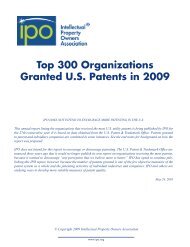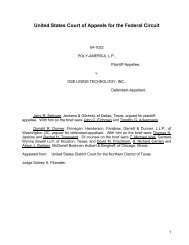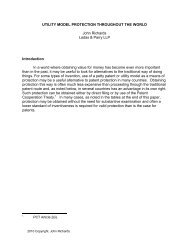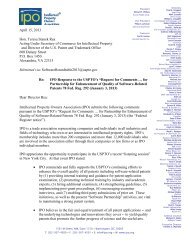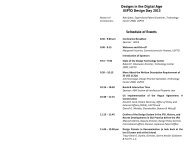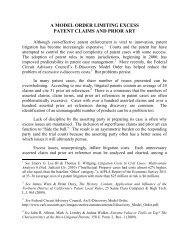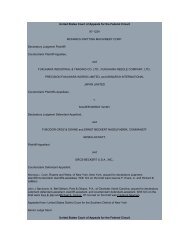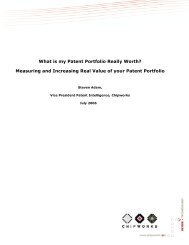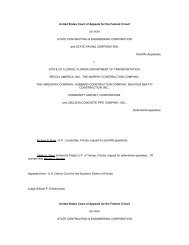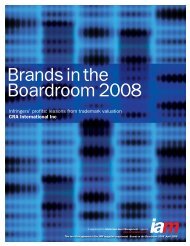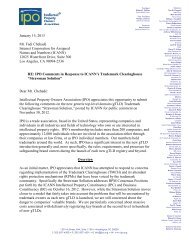Ruiz v. A.B. Chance Co.
Ruiz v. A.B. Chance Co.
Ruiz v. A.B. Chance Co.
Create successful ePaper yourself
Turn your PDF publications into a flip-book with our unique Google optimized e-Paper software.
district court found that the Fasteel methods infringed claims 1 through 4 and claims 6 through 8 of the ’368<br />
and ’107 patents. Alternatively, the district court found that <strong>Chance</strong> proved infringement under the doctrine<br />
of equivalents. Neither party disputes the district court’s claim construction.<br />
<strong>Ruiz</strong> and Fasteel contend that the district court erred in finding that their method of underpinning infringed<br />
the ’368 and ’107 patents. <strong>Ruiz</strong> and Fasteel argue that in their method, the bracket does not have to be<br />
located near the stabilizing positions when the screw anchor is screwed into the ground. Instead, the bracket<br />
may be located elsewhere, such as in a nearby truck or near a supply pile on the ground of the job site.<br />
In Fasteel’s method, because metal brackets are in existence and available for use by the installer, they are<br />
"provided" within the meaning of claim 1. There is nothing in the claims or specification which indicates that<br />
the metal bracket had to be physically attached to or located next to the foundation before the other steps in<br />
the method could proceed. Thus, we find that the district court did not commit clear error in finding that the<br />
Fasteel method infringed claims 1 through 4 and claims 6 through 8 of the ’368 and ’107 patents.<br />
III. Attorney Fees under 35 U.S.C. § 285<br />
35 U.S.C. § 285 provides for the "award [of] reasonable attorney fees to the prevailing party" in "exceptional"<br />
patent infringement cases. Whether a case is "exceptional" under section 285 is a question of fact that we<br />
review under a clearly erroneous standard. SeeHoffman-LaRoche, Inc. v. Invamed, Inc., 213 F.3d 1359, 1365,<br />
54 USPQ2d 1846, 1850 (Fed. Cir. 2000). The prevailing party must prove the exceptional nature of the case<br />
by clear and convincing evidence. SeeCarroll Touch Inc. v. Electro Mech. Sys., Inc., 15 F.3d 1573, 1584, 27<br />
USPQ2d 1836, 1845 (Fed. Cir. 1993). Only if a court finds that a prevailing party satisfies its burden of<br />
proving an exceptional case does it determine whether to award attorney fees. SeePharmacia & UpJohn <strong>Co</strong>.<br />
v. Mylan Pharms., Inc., 182 F.3d 1356, 1359, 51 USPQ2d 1466, 1468 (Fed. Cir. 1999).<br />
A finding of inequitable conduct can be the basis for awarding attorney fees under section 285. See AB<br />
<strong>Chance</strong> v. RTE <strong>Co</strong>rp., 854 F.2d 1307, 1312, 7 USPQ2d 1881, 1885 (Fed. Cir. 1988). "Inequitable conduct<br />
resides in failure to disclose material information, or submission of false information, with an intent to<br />
deceive." Kingsdown Med. <strong>Co</strong>nsultants, Ltd. v. Hollister, Inc., 863 F.2d 867, 872, 9 USPQ2d 1384, 1389 (Fed.<br />
Cir. 1988) (internal citation omitted). Both materiality and intent must be proven by clear and convincing<br />
evidence. Id. Once the threshold levels of materiality and intent have been established, "those fact findings<br />
are balanced to make the determination whether ‘the scales tilt to a conclusion that inequitable conduct<br />
occurred.’" Manville Sales <strong>Co</strong>rp. v. Paramount Sys., Inc., 917 F.2d 544, 551, 16 USPQ2d 1587, 1592 (Fed.<br />
Cir. 1990) (internal citation omitted). "The more material the omission or the misrepresentation, the lower the<br />
level of intent required to establish inequitable conduct, and vice versa." Critikon Inc. v. Becton Dickinson<br />
Vascular Access, Inc., 120 F.3d 1253, 1256, 43 USPQ2d 1666, 1668 (Fed. Cir. 1997). We review the<br />
threshold determinations of materiality and intent under the clearly erroneous standard of Fed. R. Civ. P.<br />
52(a). See Kingsdown, 863 F.2d at 872, 9 USPQ2d at 1389. We review the district court’s ultimate<br />
determination of inequitable conduct under an abuse of discretion standard. See id. at 876, 9 USPQ2d at<br />
1389.<br />
The district court found that <strong>Ruiz</strong> and Fasteel failed to prove that material information had been withheld by<br />
clear and convincing evidence. <strong>Ruiz</strong> and Fasteel claim that in prosecuting the ’368 and ’107 patents,<br />
<strong>Chance</strong> failed to properly disclose the use of screw anchors as taught in the Fuller and Rupiper methods.<br />
The district court found that the screw anchor language was properly disclosed in the specification of the<br />
’368 and ’107 patents. The district court said, "the earth anchor language in the specification combined with<br />
the reference to a piling and other materials in the patent file wrapper history are sufficient to disclose the<br />
Fuller Rupiper prior art." The district court also found that there was no evidence of intent to deceive.<br />
We agree with the district court that <strong>Ruiz</strong> and Fasteel failed to offer clear and convincing evidence of the<br />
materiality of withholding information or of an intent to deceive. At the very least, the court’s findings are not<br />
clearly erroneous. Accordingly, we affirm the district court’s judgment of no liability for attorney fees.<br />
IV. Award of <strong>Co</strong>sts under Fed. R. Civ. P. 54(d)<br />
<strong>Ruiz</strong> and Fasteel argue that the district court erred in holding that neither party was the prevailing party for<br />
the purpose of awarding costs pursuant to Fed. R. Civ. P. 54(d)(1). Rule 54(d)(1) provides for the award of<br />
"costs other than attorneys’ fees . . . to the prevailing party unless the court otherwise directs." A party who



